Digestion 101: A North to South Process
Here we are, at the end of the road. The large intestine is the final step in the process of digestion. By this point you probably more than understand the concept of digestion being a north to south process. We have talked about it at length starting first the brain and the mouth, and the importance of being in a parasympathetic state and properly chewing your foods, then of course the stomach and the dire need for proper hydrochloric acid production, how the accessory organs, the pancreas, liver and gallbladder continue the process of digestion, releasing bile, enzymes, various hormones and allowing the small intestines to finish digestion but more importantly do it’s very important job of assimilating nutrients and finally last but not least, the large intestine.
See Part One: The Brain and The Mouth
See Part Three: The Accessory Organs: Pancreas, Gallbladder and Liver
See Part Four: The Small Intestine
How it Should Work
The large intestine, or the bowel, is compromised of 3 sections, the cecum, colon and the rectum. The leftover chyme from the small intestines, passes through the illeocecal valve and first into the ascending colon. At this point in a healthy digestive system, what is left as chyme (the digested food) after the small intestines, is indigestible fibers, lots of water, sloughed off cells and bile. The large intestine is all about absorption and recycling.
As in the esophagus and the small intestine, the contents of the large intestine are pushed forward by a sequence of muscular contractions called peristalsis (a type of motility or muscular movement). After passing through the illececal valve the remains travels from the ascending colon, across the transverse colon where waste forms, into the descending colon, to the sigmoid colon and then the stool moves out of the body.
The microorganisms present in healthy flora of the large intestine, consume the waste material and excrete it as usable Vitamins K/B1/B2/B12 and butyric acid. For colon cells their primary food is butyrate (this name comes from the fact that it was first discovered in butter), they burn this fatty acid and it nourishes the cells and provides them the energy to function. Most cells in our body are nourished through the blood. The blood provides cells with glucose and fatty acids to convert into energy so they can function. The colon is poorly vascalated and has no blood circulation. Food transits through and the cells in the colon take the butyrate and use this as energy. Happy cells in the colon mean happy function. It is important that the colon has a lot of probiotics, good bacteria, the probiotics make the nutrients for the colon to be happy, since it isn’t receiving it from the bloodstream. main nutrient. soothes it.
The large intestine is not just waste management system, it also recycles water. We have all had diarrhea at some point in our lives, which we know is very watery, when things are functioning properly, (ie when we don’t have diarrhea) the water in the chyme is reabsorbed and recycled in the large intestine. 80% of the fluid from feces is reabsorbed and delivered back to liver to be cleaned. The liver dumps toxins into the bile, it makes the bile dumps into the river of bile, the gallbladder stores the bile, the squeezing happens for the bile to be released to help emulsify your fats and the process just continues to happen over and over. Once the liver cleans up those reabsorbed substances they are delivered back to the body for use, like bile, digestive enzymes and saliva. liver function is essential to digestion.
Finally, after reabsorption and recycling process has taken place, the colon forms and expels feces, the waste material. Tada, poop!
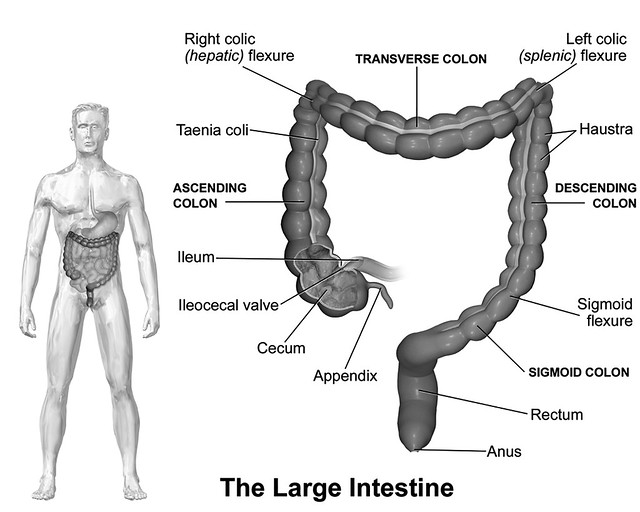
What Can Go Wrong
The large intestine’s job is to deal with the leftovers from digestion. Often due to dysfunction more north in the process, maldigested foods full of parasites, microorganisms, undigested fats and other debris, will try to pass on to colon. This can cause the illecocal valve to get clogged up and jammed and things can start to back up. An unhealthy illeocecal valve loses it’s regulatory abilities so the maldigested foods then degenerate in the colon and cause dysbiosis which will most definitely disrupt the healthy flora. organiss strarve. thrive. Without the healthy flora we aren’t getting the butyric acid that we need for the cells in the large intestine to be healthy. Weak cells can cause inflammation, diverticula, where pockets form pockets in colon where the undigested foods get impacted this among other factors can cause irritible bowel, crohn’s, colitis, celiac disease, etc.
Constipation: if you are malnourished a lot of recycling will be taking place in the large intestine, as your body’s attempting to get as much as it can, as it’s depleted. Constipation can happen as the body will hold onto the food and the stool as long as possible to suck out and recycle as much as possible. Transit time is compromised and all the fluid is pulled out of the feces. Additionally constipation can be due to a lack of fiber or dehydration.
Diarrhea: while diarrhea can certainly be a sign of irritation due to pathogens or something else that the body wants to get out immediately, it can also mean constipation and impaction. If there is impaction and chronic constipation in the colon, the digested food will want to get past it to exit, so the body will liquefy it, to move past and get out.
What You Can Do
ALWAYS Look North.
As you have gathered from reading all of these posts, at this point you know what my first suggestion will be to start north in the process. This is especially true here at the end of the digestive process.
As we spoke about in the small intestine, the specific location of the dysfunction and the protocol for managing, when we are this far into the digestive process, call more for going back in the process and starting north. Remember, we don’t want to treat the symptoms of digestion but rather to treat the system and it’s function, as a whole. All of these more north processes affect the state of which the chyme enters through the ileocecal valve and into the large intestine, so it is imperative that we start from the top, to bring proper function, before moving further south.
It is imperative that we are in parasympathetic mode, relaxed state for the proper processes of digestion to be triggered. We also must be properly chewing food. Read more about that in Part 1 – The Brain and The Mouth
After practicing these mindful eating habits, we can look next at Part 2 – The Stomach, to be sure that you are producing enough HCl. The stomach must be at the proper pH, 1.5 – 3, to activate the accessory organs to properly do their job, to release the necessary hormones, which signals the release of enzymes, bile, etc. It is important that we are properly triggering the pancreas to release it’s juices and enzymes to alkalinize the chyme and further digest the food and that we are eating the proper amount and type of fat to also trigger bile to be released to appropriately break down our fats. Read more about this in Part 3 – The Accessory Organs. We also need to be certain that the small intestine is able to continue digestion and also assimilate and absorb the proper nutrients via the villi. Read more about this in Part 4 – The Small Intestine.
All of the gut healing foods, supplements and other protocols you read so much about these days, these will all be irrelevant if you don’t first fix your digestion from the most northern places. You will end up in a vicious cycle and wasting your time and money. When the entire process is functioning as it should from the start, only then can we properly heal our gut and often times approaching our digestion from the north, the gut healing may resolve itself. When working with a client, I would never jump ahead to suggesting supplements to treat small intestine or large intestine dysfunction, before I first treated and dealt with the functions at the start of the process. There are certainly soothing symptomatic treatments to bring comfort and ease but from a standpoint of healing, I would suggest starting at the most northern positions and adjusting lifestyle, habits and healing – shifting from here, first.
Butyric Acid Supplement
Butyric acid is the naturally-occurring 4-carbon fatty acid that we spoke about above, that is formed in a healthy colon from the fermentation of dietary fiber by friendly bacteria.
While this would be considered a bandaid solution, it could be used to soothe symptoms of irritated colon while you deal with function more north in the digestive system. Raw butter is also a great source of butyric acid wonderful for inflammation in digestive tract and duh, it’s butter!!
————————————————————————
To Review the North to South Process of Digestion:
- The BRAIN is where digestion begins
- from there the food enters the MOUTH where it is chewed and broken down by the saliva that is released
- the chewed food/bolus then enters the STOMACH where a churn and burn party happens to further break it down
- the digested food/chyme then enters the SMALL INTESTINE which receives help from the LIVER, GALLBLADDER and PANCREAS to complete digestion and the available nutrients are sent throughout the body via the bloodstream
- the leftovers from the small intestine then enter the LARGE INTESTINE where we absorb the water and vitamins with the help of healthy bowel flora and any remaining unusable waste is released as feces
————————————————————————
Digestion 101: A North to South Process
Part One: The Brain and The Mouth
Part Three: The Pancreas, Gallbladder and Liver
Part Four: The Small Intestine
Part Five: The Large Intestine
This post is for educational purposes only. This information is not intended to diagnose, treat, cure, or prevent any disease. Please always seek the advice of your holistic practitioner for contraindications with other medications. I am not able to recommend or prescribe for any medical conditions, without one-on-one consultation.
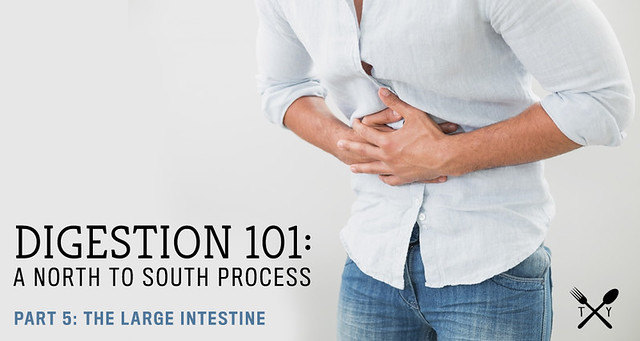
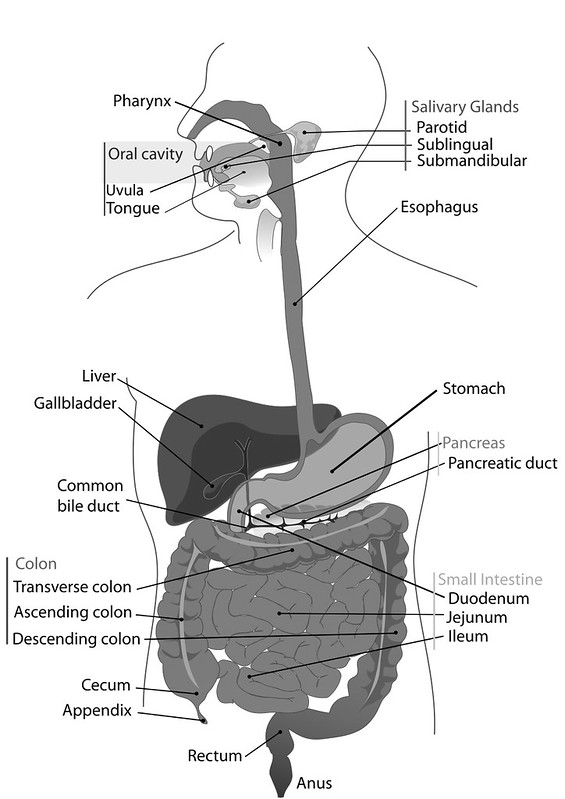
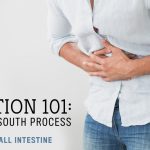
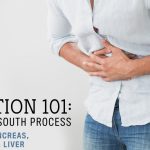
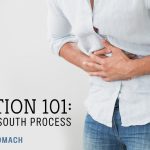
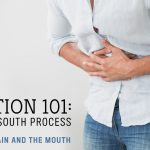


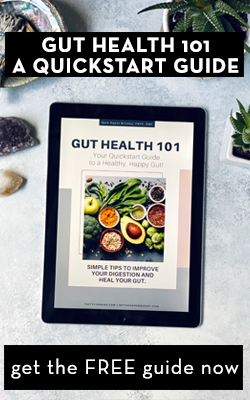




3 Responses
What if you have had your gall bladder removed? Does one need to do anything special?
Great series!
Thank you for helping me understand. I have had stomach issues for as long as I can remember but now understanding the system inside us is going to allow me to focus on much more than just the food I am putting in as I thought this was the only way to make it better.
Thanks!
Thank you. You give me hope.
My problems are mostly caused by stress I think, but I am trying to work on that. In the meantime, Onions, cabbage and broccoli seem to give me the most trouble. Have you any thoughts, apart from avoiding them altogether, on that?